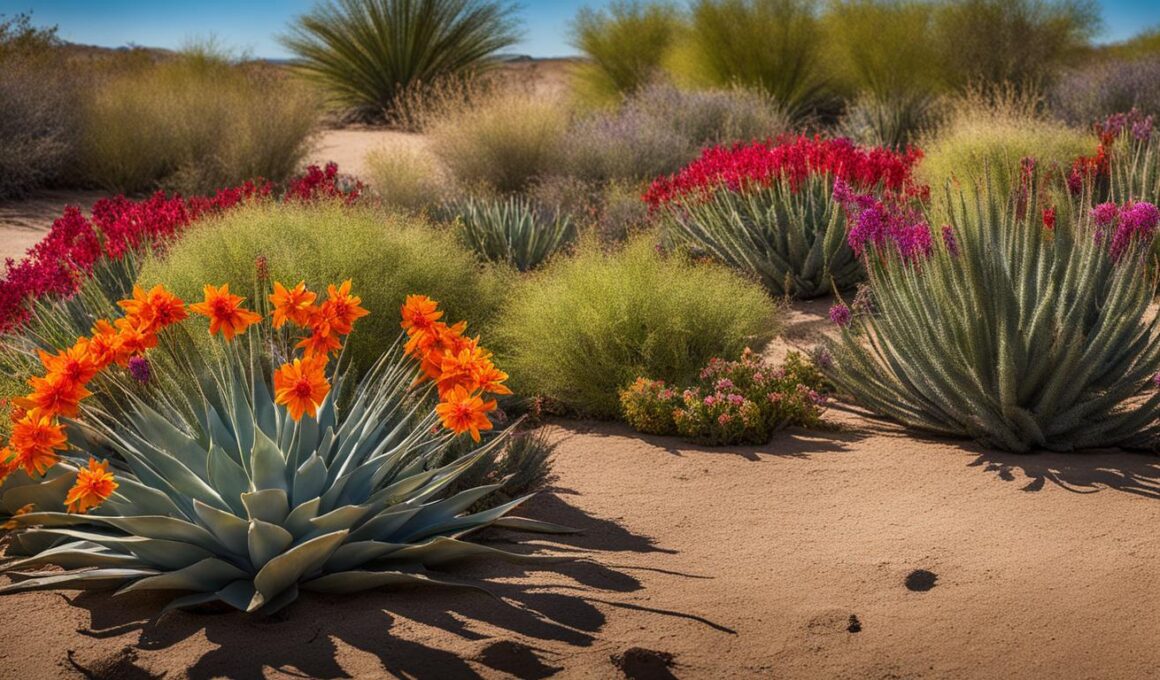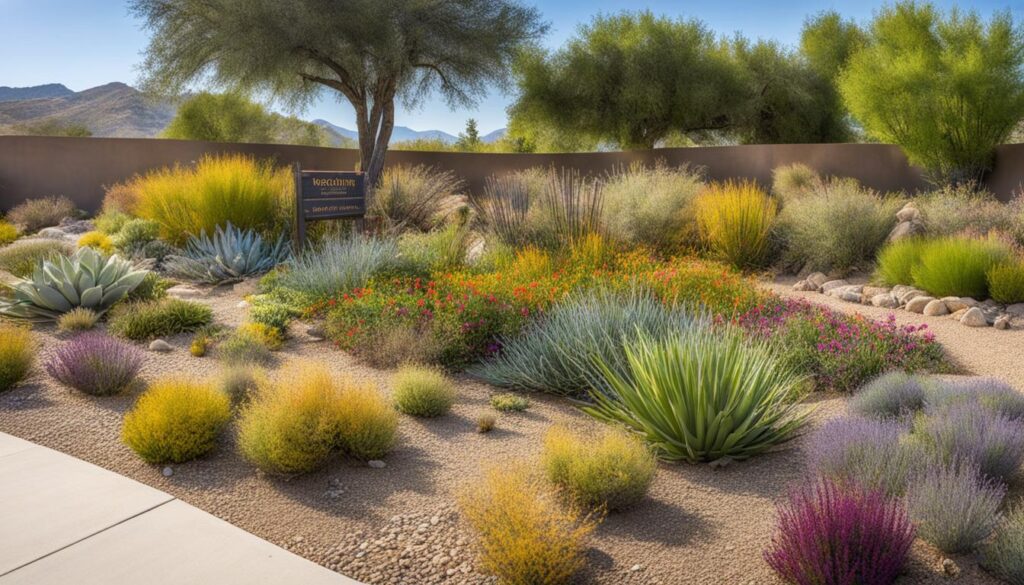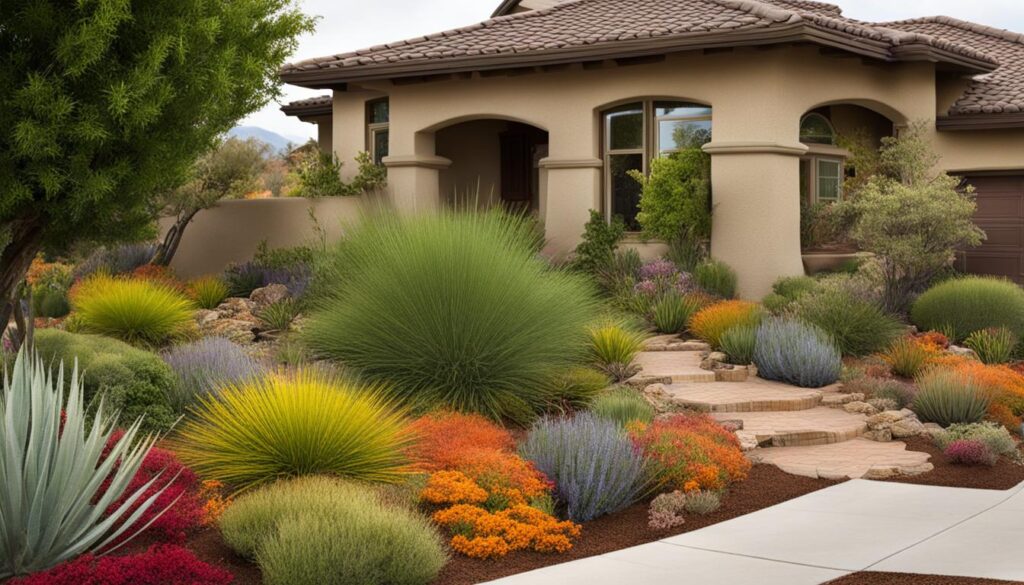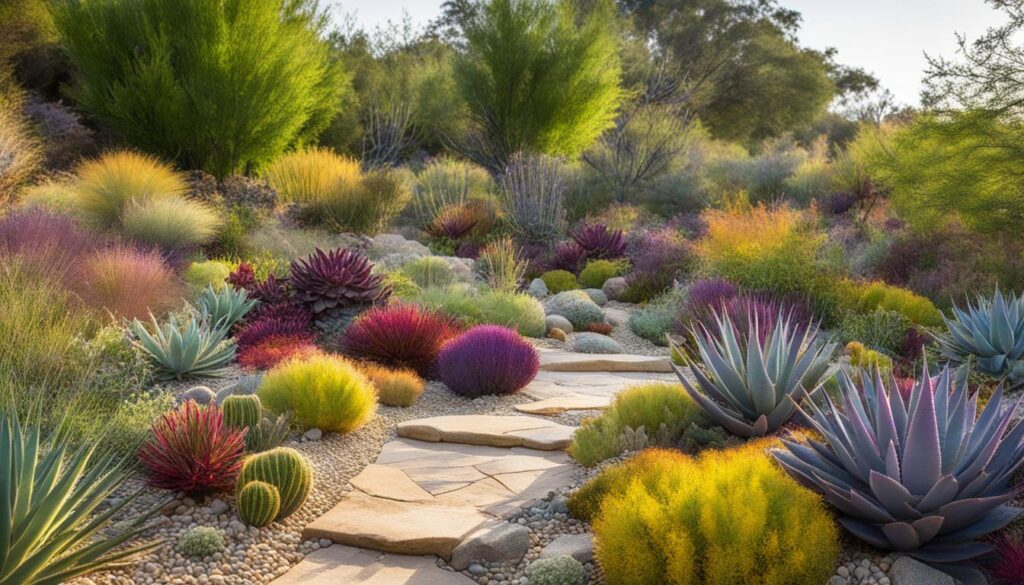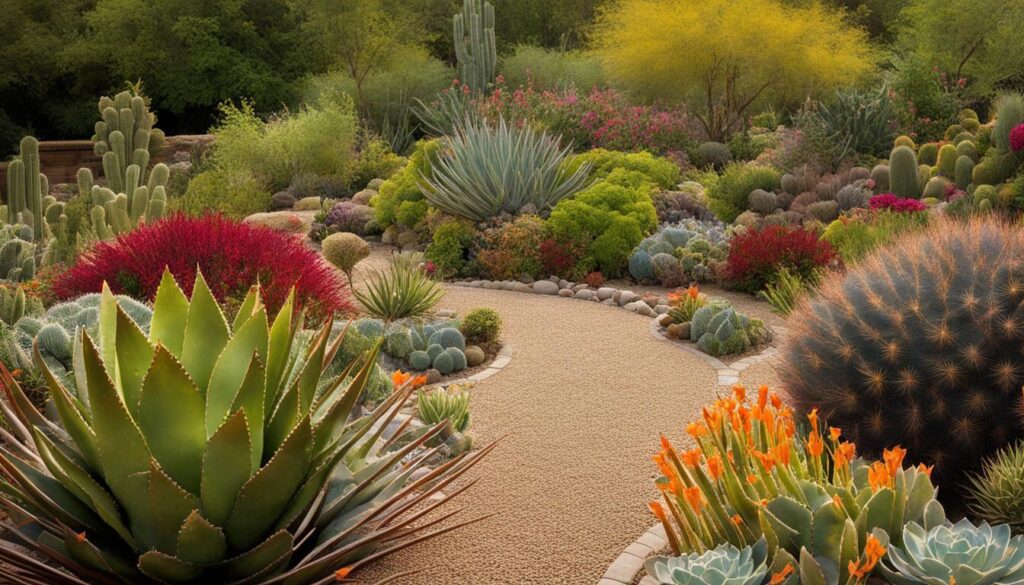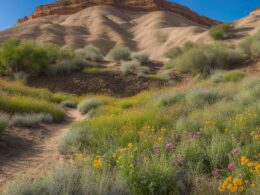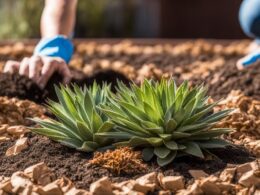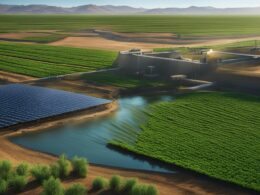Xeriscaping, also known as climate-appropriate planting, is a landscaping technique that focuses on conserving water and creating eco-friendly landscapes. Contrary to popular belief, xeriscaping is not limited to desert plants and can result in lush and beautiful gardens with minimal water usage. In many states in the US, water conservation is crucial, making the selection of climate-appropriate plants essential for creating sustainable landscapes.
- Xeriscaping is a landscaping technique that conserves water and creates eco-friendly landscapes.
- Climate-appropriate plants can be used to create lush and beautiful gardens with minimal water usage.
- Water conservation is crucial in many states in the US, making the selection of climate-appropriate plants essential.
- Xeriscaping is not limited to desert plants and offers several benefits, including water savings and eco-friendliness.
- By incorporating design principles and selecting the right plants, you can create a visually appealing and sustainable xeriscape garden.
The Misconception of Xeriscaping
Xeriscaping, also known as climate-appropriate planting, has often been misunderstood and misused, leading to the misconception that it is only about desert plants and requires no watering at all. However, this notion couldn’t be further from the truth. Xeriscaping is a landscaping technique that aims to conserve water and create eco-friendly landscapes by selecting climate-appropriate plants that can thrive in low-water conditions.
Originally coined by the Denver Botanic Gardens in the late 1970s, xeriscaping encourages the use of plants that are well-suited to the local climate, soil conditions, and water availability. It involves reducing the need for excessive watering through the careful selection of drought-tolerant plants, and minimizing water waste through thoughtful design and maintenance practices.
Contrary to popular belief, xeriscaping is not limited to sparse and barren landscapes. With the right combination of climate-appropriate plants and design principles, xeriscaped gardens can be lush, vibrant, and visually appealing.
Dispelling the Myth
One common misconception about xeriscaping is that it only involves using cacti and succulents. While these plants are indeed well-suited for arid conditions, xeriscaping encompasses a much broader range of plant species that can thrive in various climates. From native grasses and wildflowers to shrubs and trees, there is a wide selection of climate-appropriate plants available for creating sustainable and beautiful landscapes.
Understanding the Approach
Another misconception is that xeriscaping means neglecting your garden and letting it wither away. In reality, xeriscaping requires careful planning, design, and maintenance. By grouping plants with similar watering needs together and implementing efficient irrigation systems, you can ensure that your xeriscape garden receives the right amount of water without wastage. Regular maintenance, including pruning, weeding, and mulching, is also essential for the health and vitality of the plants.
Benefits of Xeriscaping
Now that we have debunked the misconceptions surrounding xeriscaping, it’s important to understand the benefits it offers. By embracing xeriscaping, you can significantly reduce your water consumption, lower your water bills, and contribute to the conservation of this precious resource. Xeriscaped gardens also require less maintenance, as climate-appropriate plants are adapted to local conditions and require minimal fertilizers and pesticides. Furthermore, xeriscaping promotes biodiversity by using native plant species, attracting pollinators, and creating habitats for local wildlife.
The Benefits of Xeriscaping
Xeriscaping offers numerous benefits that make it an attractive choice for landscaping projects in the US. One of the primary advantages of xeriscaping is water conservation. By using climate-appropriate plants that are well-suited to the local environment, xeriscaping reduces the need for excessive watering. This not only helps to conserve water resources but also results in lower water bills for homeowners and less strain on municipal water supplies.
In addition to water conservation, xeriscaping promotes the creation of eco-friendly landscapes. By incorporating native and drought-tolerant plants into the garden, xeriscaping reduces the need for fertilizers and pesticides. These plants are naturally adapted to the local climate and require less maintenance, making them a more sustainable choice. Furthermore, xeriscaping helps to preserve biodiversity by providing habitats and food sources for native birds, butterflies, and beneficial insects.
Key Benefits of Xeriscaping:
- Significant water savings
- Lower water bills
- Reduced strain on water resources
- Less need for fertilizers and pesticides
- Minimal maintenance required
- Preservation of biodiversity
“Xeriscaping not only helps to save water but also promotes a more sustainable and environmentally friendly approach to landscaping. By choosing climate-appropriate plants and implementing water-saving techniques, you can create a beautiful garden that benefits both you and the planet.”
Overall, the benefits of xeriscaping are multifaceted. From water conservation to the creation of eco-friendly landscapes, xeriscaping offers a practical and environmentally conscious solution for homeowners and gardeners across the US. By embracing xeriscaping principles and selecting climate-appropriate plants, you can enjoy a beautiful and sustainable garden while contributing to water conservation efforts and protecting the environment.
Top Xeriscaping Plants for US Gardens
When it comes to xeriscaping, choosing the right plants is essential for creating a beautiful and sustainable garden. Drought-tolerant plants are the key to conserving water and reducing maintenance while still achieving stunning landscapes. Here are some top xeriscaping plants that are perfect for US gardens:
Pelargoniums
“Pelargoniums, also known as geraniums, are a popular choice for xeriscaping due to their vibrant and colorful flowers. These drought-tolerant plants can withstand hot and dry conditions, making them ideal for US gardens. With a variety of colors and sizes to choose from, pelargoniums can add a burst of color and charm to your xeriscape.”
Yucca
“Yucca plants are not only visually striking but also highly adaptable and drought-resistant. Their architectural form adds a unique focal point to any xeriscape garden. Yuccas thrive in full sun and well-drained soil, making them a perfect choice for US gardens with hot and arid climates.”
Helleborus argutifolius
“For shaded areas in your xeriscape garden, consider planting Helleborus argutifolius. This drought-tolerant plant thrives in dry shade and offers beautiful clusters of greenish-yellow flowers during the winter months. It adds depth and interest to your garden while requiring minimal watering.”
Penstemon spectabilis
“Penstemon spectabilis, also known as Royal Penstemon, is a stunning perennial with blue-violet flowers that attract pollinators. This xeriscape plant is native to the western United States and thrives in dry and rocky soils. It’s a great choice for US gardens looking to incorporate native species and support local ecosystems.”
These are just a few examples of the many climate-appropriate plants that are suitable for xeriscaping in US gardens. By selecting drought-tolerant plants that are well-suited to your region’s climate, you can create a beautiful and sustainable landscape that conserves water and reduces maintenance. Consult with local nurseries or landscape professionals to discover more options for your specific location.
Design Principles for Xeriscaping
When it comes to xeriscaping, incorporating design principles is essential to create a sustainable and visually appealing landscape. By following these guidelines, you can ensure that your xeriscape garden not only conserves water but also enhances the aesthetic appeal of your outdoor space.
1. Plan with Purpose
Before starting your xeriscape project, take the time to assess your landscape and consider factors such as sunlight exposure, soil conditions, and water availability. By planning everything in advance, you can determine which areas require more or less water, where shade-loving plants should be placed, and how to maximize water efficiency.
2. Group Plants with Similar Watering Needs
To minimize water usage and make irrigation more efficient, arrange your plants in groups with similar watering requirements. This will allow you to tailor your watering schedule to meet the specific needs of each group, avoiding water waste and promoting healthier growth.
3. Limit Turfgrass
Turfgrass, although visually appealing, requires substantial amounts of water to maintain. Consider reducing the amount of turfgrass in your xeriscape garden and replacing it with native ground covers, gravel, or mulch. This will not only conserve water but also reduce the need for mowing and maintenance.
4. Use Targeted Irrigation Systems
Investing in targeted irrigation systems, such as drip irrigation or soaker hoses, can significantly reduce water waste. These systems deliver water directly to the plant’s root zone, minimizing evaporation and ensuring efficient water uptake.
5. Apply Mulch
Mulching is an effective way to conserve water in xeriscape gardens. Applying a layer of organic mulch, such as wood chips or bark, around plants helps to retain moisture, suppress weeds, and regulate soil temperature.
6. Maintain and Prune
To prevent excessive water usage, regularly maintain and prune your xeriscape garden. Removing dead or overgrown vegetation allows for better airflow and prevents water competition among plants.
What are the Best Climate-Appropriate Plants to Use for Xeriscaping in Dry Climates?
When it comes to xeriscaping in dry climates, it’s essential to master xeriscaping techniques and choose climate-appropriate plants. Some great options include succulents like agave and yucca, as well as drought-tolerant bushes like lavender and Russian sage. These plants can thrive in dry conditions and help conserve water.
Creating a Xeriscape Garden
Creating a xeriscape garden involves careful planning and the right selection of climate-appropriate plants. By implementing water-wise planting techniques and sustainable landscaping practices, you can create a beautiful and eco-friendly garden that requires minimal watering and maintenance.
Start by assessing your local climate, soil conditions, and water availability. Choose plants that are well-suited to thrive in these conditions, such as drought-tolerant species that require less water to flourish. Incorporate a variety of plants including ground covers, shrubs, and trees to add visual interest and create biodiversity in your garden.
Consider grouping plants with similar watering needs together to optimize water usage and reduce waste. Implement targeted irrigation systems, such as drip irrigation or soaker hoses, to provide water directly to the roots of the plants, minimizing evaporation and runoff. Applying mulch around plants helps to retain moisture in the soil, reducing the need for frequent watering.
“Xeriscaping is about creating a harmonious and sustainable garden that thrives in a water-wise environment.”
To further enhance the sustainability of your xeriscape garden, practice eco-friendly maintenance. Regularly monitor and adjust your irrigation system to ensure efficient water usage. Prune and trim plants as needed to promote healthy growth and prevent excessive water consumption. Embrace organic gardening practices, such as composting and natural pest control, to minimize the use of harmful chemicals.
By creating a xeriscape garden, you can transform your outdoor space into a vibrant and sustainable oasis. With the right plant selection, water-wise planting techniques, and sustainable landscaping practices, you can enjoy a beautiful garden while conserving water and supporting the environment.
What Types of Climate-Appropriate Plants Are Suitable for Xeriscaping in the US?
When considering xeriscaping in the US, it’s important to choose climate appropriate xeriscaping plants that can thrive in the specific region’s conditions. Some suitable options include yucca, lavender, agave, and sedum. These drought-tolerant plants can help conserve water and create a sustainable, low-maintenance landscape.
What Climate-Appropriate Plants are Best for Xeriscaping with Native Grasses and Flowers in the US?
In sustainable landscape design with xeriscaping, it’s best to choose climate-appropriate plants for xeriscaping in the US. Native grasses and flowers such as Blue Grama, Purple Coneflower, and Black-eyed Susan are great choices. These plants are low-maintenance and require minimal water, making them perfect for xeriscaping projects.
Conclusion
Xeriscaping, or climate-appropriate planting, is the ideal solution for creating sustainable and visually appealing landscapes in the United States. By carefully selecting climate-appropriate plants, you can conserve water while still enjoying lush and beautiful gardens. With the increasing importance of water conservation and environmental sustainability, xeriscaping has gained popularity as a practical and eco-friendly landscaping technique.
By incorporating a variety of drought-tolerant plants into your landscape, you can minimize water usage and create a garden that thrives in low-water conditions. With the right design principles, such as grouping plants with similar watering needs and using targeted irrigation systems, you can further reduce water waste and ensure the long-term success of your xeriscape garden.
Whether you live in a water-scarce region or simply want to make your landscape more eco-friendly, xeriscaping is a smart choice. By embracing climate-appropriate plants and implementing sustainable design practices, you can create a visually stunning and water-wise garden that not only enhances the beauty of your property but also contributes to a more sustainable future for the environment.





